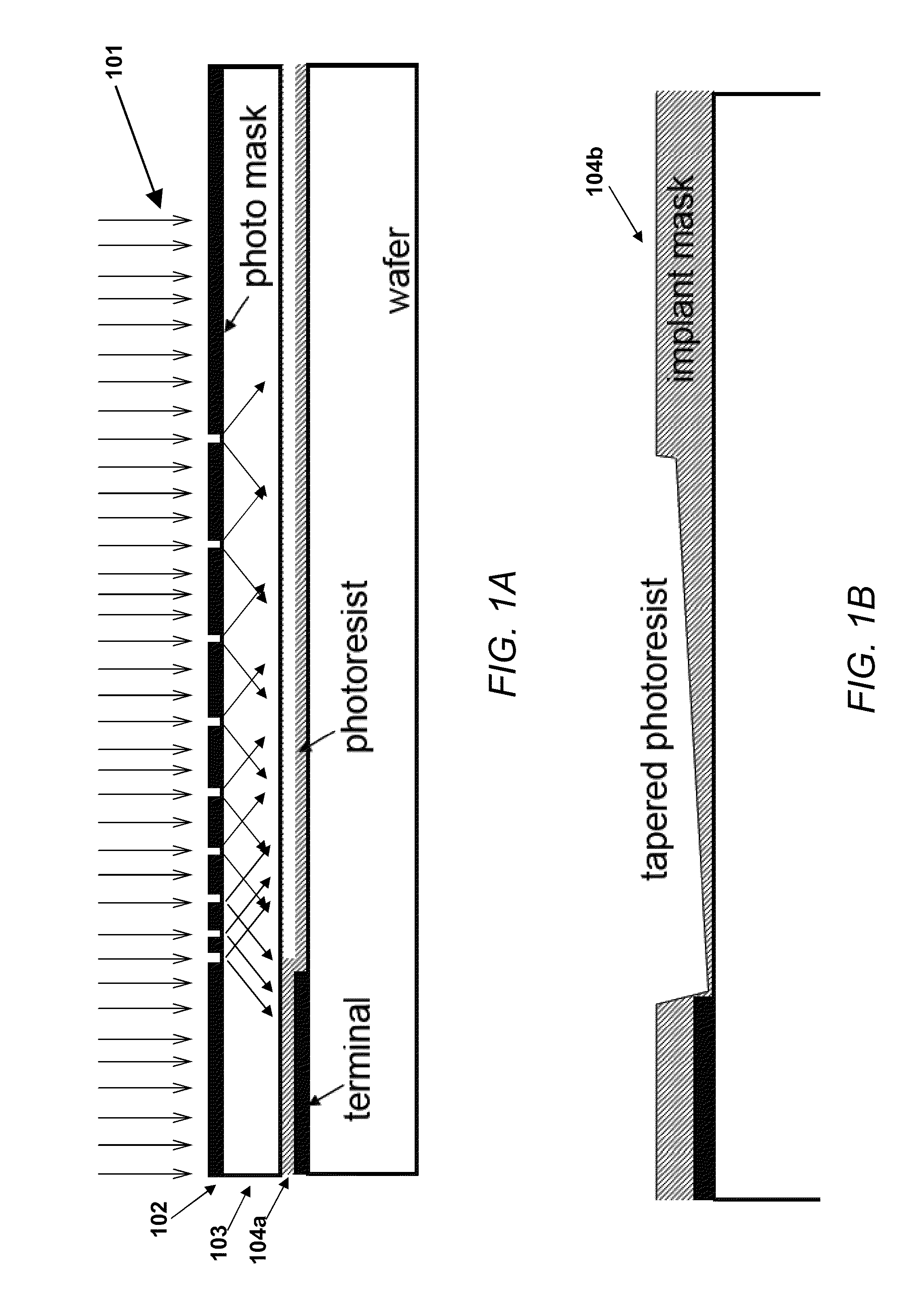Junction Termination Extension with Controllable Doping Profile and Controllable Width for High-Voltage Electronic Devices
a technology of junction termination and controllable width, applied in the field of semiconductor devices, can solve the problems of time and money, the dopant does not diffuse effectively in silicon, and the dopant island-implantation technique that provides a smooth graded junction termination doping profile in silicon does not work well
- Summary
- Abstract
- Description
- Claims
- Application Information
AI Technical Summary
Benefits of technology
Problems solved by technology
Method used
Image
Examples
example 1
[0037]1. Use a specially designed mask, separated from the photoresist by a controlled gap or clear spacer, to produce a laterally tapered photoresist layer having controlled arbitrary lateral thickness profile and a controlled arbitrary lateral width on the semiconductor substrate in the junction termination extension region surrounding the high voltage junction.
[0038]2. Develop and bake the photoresist, using any conventional methods for developing a photoresist, such as immersion in a commercially available development solution for a time on the order of 1 minute followed by baking with a 120 degree Celsius oven or hotplate.
[0039]3. Optionally convert the photoresist to graphite (or carbon) by heating at approximately greater than 500 C in a nitrogen or argon ambient. The resist will flow and smooth out to some degree during the heating.
[0040]4. Perform a dopant ion implantation (for example, P-type dopant such as boron or aluminum) at a selected ion implant energy and dose into ...
example 2
[0045]1. Form a dopant layer in a semiconductor.
[0046]2. Use a specially designed mask, separated from the photoresist by a controlled gap or clear spacer, to produce a laterally tapered photoresist layer having a controlled arbitrary lateral thickness profile and a controlled arbitrary lateral width on the semiconductor substrate in the junction termination extension region surrounding the high voltage junction.
[0047]3. Develop and bake the photoresist.
[0048]4. Optionally convert the photoresist to graphite (or carbon) by heating at approximately greater than 500 C in a nitrogen or argon ambient. The resist will flow and smooth out to some degree during the heating.
[0049]5. Use an RIE etcher to simultaneously etch laterally tapered material (for example, photoresist) and the semiconductor material. Typically, the etch rate of the laterally tapered material and the semiconductor material will be at different rates, but for optimized etch gases, RF power, and pressure in the RIE, nea...
example
[0067]Creation of a junction termination extension having a controlled arbitrary lateral doping profile and a controlled arbitrary lateral width using a gray-scale lithography technique and tapered implantation mask having one or more features described herein is now described in the context of the following example.
[0068]The lithography technique and implantation mask were implemented in all-implanted silicon carbide pn junction diodes. The starting material was 38 μm of n-doped (7×1014 cm−3) epitaxy grown on top of an n+ buffer layer on an 8° off-axis 4H—SiC substrate. After creating alignment features with reactive ion etching, a thick layer of positive photoresist was spin-deposited on the wafer.
[0069]The tapered implantation mask was formed using a grayscale lithography technique. Grayscale exposure was accomplished by using a two-tone sub-resolution mask. In this exemplary implementation, the mask had circular diode anode openings that were 100 μm in diameter. Around the anode...
PUM
 Login to View More
Login to View More Abstract
Description
Claims
Application Information
 Login to View More
Login to View More - R&D
- Intellectual Property
- Life Sciences
- Materials
- Tech Scout
- Unparalleled Data Quality
- Higher Quality Content
- 60% Fewer Hallucinations
Browse by: Latest US Patents, China's latest patents, Technical Efficacy Thesaurus, Application Domain, Technology Topic, Popular Technical Reports.
© 2025 PatSnap. All rights reserved.Legal|Privacy policy|Modern Slavery Act Transparency Statement|Sitemap|About US| Contact US: help@patsnap.com



